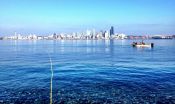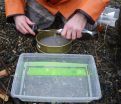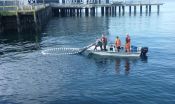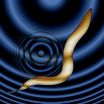(Press-News.org) In the midst of ferry boats, container ships and tourists crowding Seattle's Elliott Bay, young salmon are just trying to get a decent meal.
The fish hatch in the rivers and streams that feed into Puget Sound and almost immediately rely on eating small organisms near the shore, including in the heart of Seattle's commerce-filled waterfront.
Though salmon share the busy Elliott Bay waters with boats and barges, scientists suspect built-up, "armored" shorelines and large piers may be the main culprits disrupting fish habitat. These artificial structures block light and confuse the fish as they make their way to the ocean.
But are concrete seawalls actually affecting what the salmon eat, and by how much? A University of Washington study shows that it depends on the species, with small chum salmon seeming to be most affected.
The study looked at the diets of young salmon passing through Elliott Bay. Researchers measured the types of prey in the water along armored shorelines and along restored beaches. Scientists then collected young salmon in nets -- corralled by boats or divers -- and flushed out their stomachs to look at what they ate recently.
The stomach contents showed that young pink and Chinook salmon that feed on organisms either floating in the water or on the water's surface were able to eat the same amount of food, whether they were feeding near a concrete shoreline such as Seattle's ferry terminal at Coleman Dock or along shoreline that has been restored to look like a natural beach, including along Seattle Art Museum's Olympic Sculpture Park.
However, young chum salmon that munch on critters found mainly in bottom habitats had a noticeable change in their eating patterns depending on the type of shoreline. These small chum salmon ate more invertebrates floating in the water when swimming by armored sites, and more bottom-dwelling crustaceans -- which they prefer -- when feeding near beaches. Larger juvenile chum behaved more like their pink and Chinook counterparts.
"Our study shows that armoring affects what species of prey are available," said lead author Stuart Munsch, a UW doctoral student in aquatic and fishery sciences. "Fish that normally eat those missing prey will feed on alternative species at armored sites, but we don't know what the costs of that change are to the fish."
The findings were published Sept. 15 in the journal Marine Ecology Progress Series.
The article details the latest in a series of recent studies along Seattle's waterfront that is trying to better understand how fish behave in urban, industrial waterways. The shores of Elliott Bay are almost fully walled-in with concrete and riprap, a layer of large stones designed to keep soil from eroding. The most natural shorelines are along several manmade sandy beaches, restored recently for public recreation and natural beauty.
The study confirmed that areas converted to look like beaches attract more diverse organisms, including small crustaceans known as harpacticoid copepods. These weren't seen much along armored shorelines, which instead had more barnacles -- not an appetizing choice for young salmon.
"Engineered shorelines like these manmade beaches are going to have more components of a natural ecosystem than a featureless wall," said co-author Jeff Cordell, lead investigator on the project and a UW research scientist with aquatic and fishery sciences. "Manmade beaches will produce more diversity and numbers of the kinds of food juvenile salmon utilize."
The researchers found that while the types of organisms in the water did indeed change depending on shoreline, only the small chum salmon actually adjusted what they ate.
Maybe the other fish, the pink, Chinook and larger chum salmon, ate prey that wasn't directly affected by the type of shorelines present -- such as plankton, which was in the water at both locations -- or were large and strong enough to swim through both areas, eating along the way, before their stomach contents were measured.
But small chum salmon are especially dependent on the tiny crustaceans more common along restored beach sites. And while none of the fish studied were starving, the fish whose diets changed may have used up considerable energy trying to keep a balanced diet.
"The [type of] copepods that chum salmon usually feed on are brightly colored and they're found near the bottom," Munsch said. In other words, the chum's typical diet is easy prey. "We think that chum salmon along armored shorelines might have to spend more energy searching for prey that are harder to see, or chasing prey that are more evasive, when that energy should be allocated to growth or migration."
This study and other recent papers by Cordell's research team are informing Seattle's Seawall Project, which is replacing the current waterfront wall with a structure that intends to be friendlier to fish while protecting city infrastructure.
INFORMATION:
The research was funded by the Seattle Department of Transportation and a National Science Foundation Graduate Research Fellowship. Jason Toft, a research scientist in UW fisheries, is another co-author on this paper.
For more information, contact Cordell at jcordell@uw.edu or 206-543-7532 and Munsch at smunsch@uw.edu.
Reminders to take medication, delivered to patients via an electronic pillbox, may be able to improve adherence to tuberculosis (TB) treatment. The findings, reported this week in PLOS Medicine, are the result of a cluster randomized controlled trial by Shiwen Jiang of the Chinese Centers for Disease Control & Prevention, Katherine Fielding, of the London School of Hygiene & Tropical Medicine, and colleagues.
The study randomized 36 districts in the provinces of Heilongjiang, Jiangsu, Hunan, and Chongqing, China to receive one of four approaches to tuberculosis case management: ...
Selective serotonin reuptake inhibitor (SSRI) use is modestly associated with violent crime, according to a study published this week in PLOS Medicine. The cohort study, by Seena Fazel from the University of Oxford, and colleagues, showed in subgroup analysis that this association was evident in participants aged 15-24, but not significant for individuals aged 25 and older.
SSRIs are widely prescribed, but inconclusive evidence links SSRI use with violent behavior. In this study, Fazel and colleagues compared the rate of violent crime while individuals were prescribed ...
Giving electronic reminders to tuberculosis (TB) patients in China can reduce the amount of medication doses they miss by half, according to new research published in PLOS Medicine.
Researchers from the London School of Hygiene & Tropical Medicine, UK, and the National Center for Tuberculosis Control and Prevention, China, conducted a trial with 4,173 patients from the provinces of Heilongjiang, Jiangsu, Hunan, and Chongqing. Patients either received text message reminders, an electronic medication monitor, both, or no reminders for their six month treatment period.
Patients ...
Measuring how religion affects a person's political attitudes and behavior can provide powerful insight to everyone from pundits to presidents.
Now there's a new strategy to gather better, more nuanced perspective on that religious influence than ever before, developed by University of Cincinnati researchers.
UC's Andrew Lewis and Stephen Mockabee presented research titled "Measuring Biblical Interpretation and Its Influence on Political Attitudes" at the American Political Science Association's annual meeting earlier this month in San Francisco. The association serves ...
MEDFORD/SOMERVILLE, Mass. (Sept. 15, 2015) -- Regenerative medicine using stem cells is an increasingly promising approach to treat many types of injury. Transplanted stem cells can differentiate into just about any other kind of cell, including neurons to potentially reconnect a severed spinal cord and repair paralysis.
A variety of agents have been shown to induce transplanted stem cells to differentiate into neurons. Tufts University biomedical engineers recently published the first report of a promising new way to induce human mesenchymal stem cells (or hMSCs, which ...
A quarter of a century ago, the physicist, physician and cell biologist Professor Thomas Jentsch and his research team opened up an entirely new field of research in the field of ion transport. Now the British journal "The Journal of Physiology"* has devoted a special section in its latest issue to his discovery. In this issue (DOI: 10.1113/jphysiol.2014.270043), Professor Jentsch, who leads a research group at the Max Delbrück Center for Molecular Medicine in the Helmholtz Association (MDC) and at the neighboring Leibniz-Institut für Molekulare Pharmakologie ...
New research from the USA suggests that college students are well aware that they should be personally responsible for their finances, including their card obligations, but this awareness rarely correlates with limiting the debts they accrue during their time in higher education. Details of the study are reported this month in the International Journal of Behavioural Accounting and Finance.
Lucy Ackert of the Department of Economics and Finance, at Kennesaw State University, in Georgia, and Bryan Church of the Scheller College of Business, at Georgia Tech, Atlanta, ...
The most obvious disadvantage of putting your data in the cloud is losing access when you have no internet connection. According to research publishes in the International Journal of Cloud Computing, this is where "dew" could help. Yingwei Wang of the Department of Computer Science, at the University of Prince Edward Island, Charlottetown, Canada, describes what he refers to as a "cloud-dew" architecture that offers an efficient and elegant way to counteract cloud downtime and communication difficulties.
In the world of cloud computing, users and organizations keep their ...
MANHATTAN, KANSAS - U.S. farmers are growing fewer types of crops than they were 34 years ago, which could have implications for how farms fare as changes to the climate evolve, according to a large-scale study by Kansas State University, North Dakota State University and the U.S. Department of Agriculture. Less crop diversity may also be impacting the general ecosystem.
"At the national level, crop diversity declined over the period we analyzed," said Jonathan Aguilar, K-State water resources engineer and lead researcher on the study.
The scientists used data from ...
LA JOLLA--Salk scientists have developed a new way to selectively activate brain, heart, muscle and other cells using ultrasonic waves. The new technique, dubbed sonogenetics, has some similarities to the burgeoning use of light to activate cells in order to better understand the brain.
This new method--which uses the same type of waves used in medical sonograms--may have advantages over the light-based approach--known as optogenetics--particularly when it comes to adapting the technology to human therapeutics. It was described September 15, 2015 in the journal Nature ...



